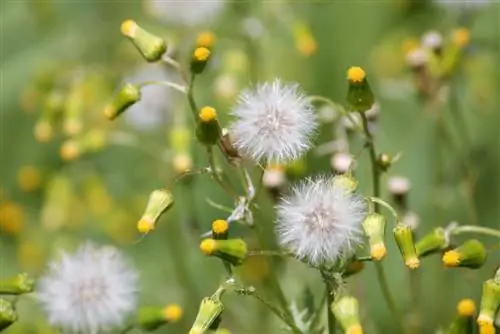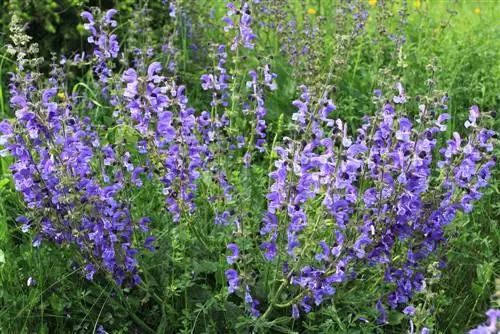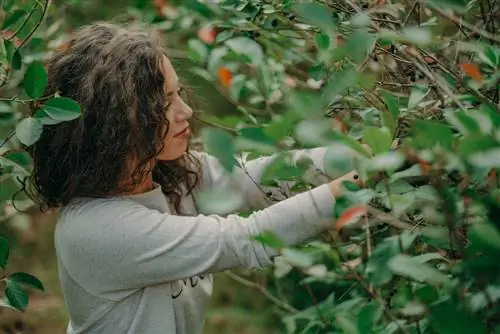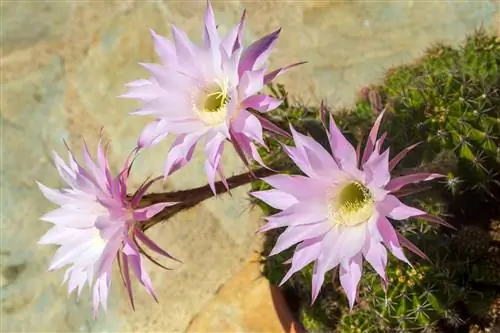- Author admin [email protected].
- Public 2023-12-16 16:46.
- Last modified 2025-06-01 06:02.
Read the commented ragwort profile here for useful information about growth, leaves, flowers and toxicity. Five common ragwort species at a glance. Useful tips about planting and caring for ragwort.
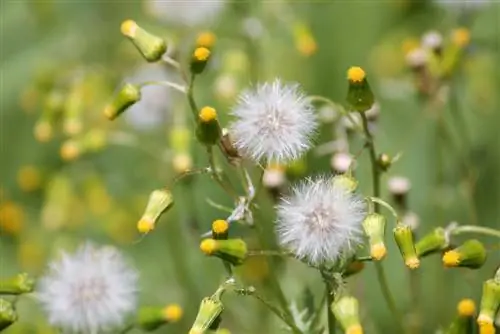
What is groundsel and which species are common?
Rosewort (Senecio) is a herbaceous plant with over 1000 species, yellow cup flowers and a height of 10-30 cm. It is considered toxic due to the pyrrolizidine alkaloid content and can cause liver damage if consumed. Typical species are common, narrow-leaved, white-felted, rocket-leaved, and Jacob's ragwort.
Profile
- Scientific name: Senecio vulgaris
- Family: Daisy family (Asteraceae)
- Genus: Oldweed with 1000+ species
- Synonym: Ragwort
- Occurrence: worldwide neophyte
- Growth type: herbaceous plant
- Growth height: 10 cm to 30 cm
- Leaf: rich in shapes
- Flower: basket
- Fruit: Achene with Pappus
- Toxicity: poisonous
- Winter hardiness: sensitive to frost
Growth
Rosewort is a native, widespread plant species from the cosmopolitan genus Senecio. The botanical name Senecio vulgaris is popularly associated with numerous synonyms, such as common groundsel, common groundsel, common groundsel or simply groundsel. Read these important features of growth in summary:
- Growth type: herbaceous plant with yellow basket flowers and a short lifespan (therophyte).
- Growth height: 10 cm to 30 cm.
- Root system: richly branched, filigree root strands up to a depth of 45 cm.
- Occurrence in Central Europe: ruderal areas, construction sites, rubble dumping areas, arable land, railway embankments, overgrown parks and gardens.
- Gardenically interesting properties: easy-care wild herb, short-lived, sensitive to frost, bee-friendly, decorative flower and fruit heads, poisonous.
Long ago frowned upon as a weed, common groundsel with its authentic, rustic growth is increasingly valued as a wild herb for natural garden design.
Video: Common groundsel in portrait
Bloom
Racewort belongs to the daisy family (Asteraceae). This association is reflected in naturally beautiful flowers with these identifying features:
- Inflorescence: umbel-like entire inflorescence with numerous individual basket flowers.
- Single flower: Flower heads with double perianth and 60 to 80 tubular flowers (outer cover with 10 lanceolate, dark brown-tipped bracts).
- Cup shape: cylindrical, narrowed at the top.
- Flower size: 4 mm wide, 8 mm long.
- Flower color: yellow
- Flower ecology: hermaphrodite
- Flowering time: at any time of the year, main flowering in summer.
- Pollination: bees, hoverflies, spontaneous self-pollination.
- Fruit: nut-like fruit with white hairs and seeds as umbrella flyers (hence the name groundsel).
In contrast to most ragwort species, Senecio vulgaris does not produce ray florets. This is a helpful criterion for accurately distinguishing common ragwort from the highly poisonous ragwort (Senecio jacobaea).
Leaf
Racewort is an annual or annual overwintering wild plant. When overwintering, ragwort often thrives as a semi-rosette plant. During the cold season, some of the leaves gather at the base of the stem to form a loose rosette from which the shoot axis emerges in spring. In any case, decorative leaves sit along the stem. You can clearly identify ragwort even outside of its flowering period by these leaf characteristics:
- Leaf shape: pinnate or ovoid-pinnate.
- Single leaflets: coarsely toothed to bluntly split, broadened towards the tip of the leaf.
- Leaf color: green, mostly glabrous, rarely tomentose hairy.
Racewort species
Of the more than a thousand ragwort species worldwide, these five ragwort species are particularly common in this country:
| Racewort species | Common ragwort | Narrow-leaved ragwort | White Tomentose Ragwort | Rocket-leaved ragwort | Jacobs ragwort |
|---|---|---|---|---|---|
| Botanical name | Senecio vulgaris | Senecio inaequidens | Senecio cineraria | Senecio erucifolius | Senecio jacobaea |
| Synonym | Common Ragwort | Narrow-leaved Ragwort | Silverleaf | Rockwort Ragwort | Scallop Ragwort |
| Growth habit | herbaceous, upright | herbaceous, upright | branched subshrub | herbaceous, runner-forming | herbaceous, upright, with rosette of leaves |
| Growth height | 10-30 cm | 30-60 cm | 25-60 cm | 30-120 cm | 30-100 cm |
| Leaf shape | pinnate, toothed | ruled, serrated | lobed, feathered, hairy | feathered with ears | pinnate, bluntly toothed |
| Flowering time | all year round | June to November | July to October | July to September | July to October |
| Life Stage | annual, overwintering annual | annual | annual | persistent | persistent |
| Status | Ruderal plant | invasive neophyte | Decorative leaf plant | local wild herbs | Poison plant |
Toxicity
Common ragwort is poisonous. All parts of the plant contain pyrrolizidine alkaloids. These toxic, secondary plant substances are hazardous to the he alth of humans and animals. If consumed intentionally or unintentionally, the substances can, in the worst case scenario, cause serious liver damage, trigger cancer or alter the genetic makeup. Ragwort poses a particular danger to grazing livestock, horses and pets. Hobby gardeners should avoid direct skin contact with the plant sap. However, the concentration of poison in Senecio vulgaris is significantly lower than in Senecio jacobaea, the dreaded ragwort.
Excursus
Silver leaf - structural plant for the flower bed
Silver leaf is the most popular groundsel for creative garden design. With its silvery, shiny decorative leaves, white tomentose ragwort (Senecio cineraria) creates decorative visual axes in perennial beds or is useful as a representative border. As a planting partner for fiery red phloxes (phlox), sunny yellow lilies (Hemerocallis) or sky blue lupins (Lupinus), silver leaf makes the colors of all summer flower beauties shine more intensely.
Planting ragwort
Common ragwort or other ragwort species are easy to plant. Sowing is inexpensive and uncomplicated. The main thing that can be bought ready to plant is the pretty white tomentose ragwort. The best planting tips for beds and balconies to read:
Sowing
These are the ideal conditions for growing ragwort by sowing:
- Preparation: Put on gloves, soak seeds in water.
- Time: end of February to beginning of April.
- Location options: windowsill, greenhouse, winter garden, cold frame.
- Seed containers: bowl, growing pot, coconut seed pot.
- Growing substrate: commercially available seed soil, mix of peat-free potting soil, sand and coconut fiber substrate.
- Sowing depth: Press light germinators into the soil to a maximum depth of 0.5 cm or sieve thinly and press down with wooden boards.
- Germination time and temperature: 2 to 4 weeks at 15° to 18° Celsius.
- Care: water in dry conditions, do not fertilize, after emergence, separate to 5×5 cm.
Direct sowing of groundsel seeds is possible from the end of April/beginning of May. However, this variant usually results in winter annual growth. The young plants overwinter as leaf rosettes and only bloom in the second year.
Location
As a ruderal plant, groundsel thrives even in inhospitable places. If the wild herb is granted this location, its natural charm unfolds in all its glory:
- Sunny location without direct sunlight from midday onwards.
- Warm, preferably with temperatures above 15° Celsius.
- Normal garden soil, humus, nutrient-rich, fresh to moderately dry and well-drained.
- Ideal pH value 5.5 to 6.5.
- Extra tip: enrich compacted clay soil with sand and compost soil.
Planting
The best time to plant early or purchased groundsel is in the spring after the last heavy frost. In regions with harsh winters, the time window for planting in beds and pots opens in mid-May after the Ice Saints. Planting tips worth knowing for the garden and balcony:
- The diameter of the planting hole is twice as large as the root ball.
- Place ragwort root balls in water for 10 to 20 minutes before planting.
- Planting distance in the bed: 25 cm to 30 cm.
- Suitable potting substrate: Potting soil without peat with expanded clay, lava granules or sand as an additive.
- Cover the bottom of the pot 3-5 cm high with potsherds, grit or expanded clay as drainage.
- Plant ragwort in the bed and pot at the same depth as before in the growing pot or purchase container.
Care for ragwort
Redwort is easy to care for. It is important to ensure reliable protection against the poisonous plant sap in the form of non-slip gloves with cuffs. The simple care program includes a needs-based supply of water and nutrients. Pruning at the right time prevents unwanted self-seeding. Optionally, groundsel can overwinter in a pot. In the family garden, combating ragwort may make sense. Read helpful tips and tricks about ragwort care here:
Pouring
- Water ragwort in the bed if the drought persists.
- Water potted plants thoroughly when the substrate is noticeably dry.
- Preferably use collected rainwater or stale tap water as irrigation water.
Fertilize
- In the bed, fertilize with horn shavings (€52.00 on Amazon) if there are noticeable deficiency symptoms (yellowish leaves, pale colors, sparse flowers).
- Add a liquid flower fertilizer to the water in the pot every two weeks from May to September.
Cutting
Rosewort is also becoming unpopular as a neophyte in Central Europe. After flowering and fruit ripening, ragwort sends myriad winged seeds on their journey, which settle as umbrella fliers throughout the garden. With the right incision care, you can put a stop to the invasive urge to spread. This is how it works:
- Clean up wilted inflorescences as soon as possible with gloved hands.
- Alternatively, cut back spent stems to 10 cm, in time before the seeds ripen.
- Important: Only compost clippings if they do not contain any toxic fruit stalks.
Regularly cleaning out withered flower heads has the advantage that new basket flowers constantly develop for an extra long flowering period.
Wintering
With delayed direct sowing or cool weather conditions, groundsel thrives as an annual overwintering semi-rosette plant. In this case, the wild weed is grateful for a cover with autumn leaves and brushwood as light winter protection. Do you consider the effort of overwintering to be worthwhile for particularly beautiful old herbs in the pot? Then put the wild beauties into winter quarters with temperatures around 12° Celsius before the first frost.
Special case: fighting ragwort
Poisonous ragwort, especially ragwort, is an uninvited guest within the reach of children and pets. If the wild weed boldly nests in the garden, these control methods have proven to be effective in practice:
- Clutch individual ragwort specimens by the stem before and during flowering and pull them out of the ground.
- Ideally, cut out each wild weed with a spade or hand shovel.
- Severly infested areas should be scythed or mowed several times a year to prevent the formation of flowers and seeds.
- Best prevention: Activation of soil life by avoiding artificial fertilizers and pesticides in favor of organic soil activators.
The control measures are not aimed at completely eradicating ragwort. The poisonous wild weed should only be removed from the immediate surroundings of children, pets, horses and grazing livestock. In this way, ragwort species remain as food plants for hungry wild bees, rare butterflies and useful hoverflies.
Popular varieties
These ragwort species score points with their decorative attributes and are recommended as a worthwhile design component in the garden and on the balcony:
- Golden ragwort (Senecio doria): golden yellow flowers from July to September over blue-green, lanceolate, 40 cm long decorative leaves, height up to 80 cm at the time of flowering.
- Fox groundsel (Senecio nemorensis ssp. fuchsii): striking, yellow ray flowers surround numerous yellow tubular flowers, height 60 cm to 180 cm.
- South African ragwort (Senecio polydon): rare variety with purple-pink flowers from June to September, easy-care rock garden perennial, growth height up to 50 cm.
- Peas on a ribbon (Senecio rowleyanus): unusual trailing ragwort plant with spherical leaves, beautiful in the indoor hanging basket, tendril length up to 25 cm.
FAQ
Is ragwort poisonous?
All ragwort species are poisonous to varying degrees. Widespread common ragwort (Senecio vulgaris) or the popular silverleaf (Senecio cineraria) contain a much lower concentration of toxic pyrrolizidine alkaloids than fox ragwort (Senecio ovatus) or narrow-leaved ragwort (Senecio inaequidens). The highest risk potential for humans and animals is ragwort (Senecio jacobaea), which can cause significant symptoms of poisoning even if consumed in small quantities.
Can you plant groundsel in a pot?
Various species of groundsel are suitable for cultivation as pot plants. These include common groundsel (Senecio vulgaris), white tomentose groundsel (Senecio cineraria) and golden groundsel (Senecio doria). For flower-rich growth, a regular supply of water and nutrients as well as frequent cleaning of withered flower heads are important. Always plant groundsel in a pot with a drainage layer of pottery shards on the bottom of the pot.
How can you tell the difference between common groundsel and ragwort?
Common groundsel (Senecio vulgaris) and ragwort (Senecio jacobaea) can be easily distinguished by two characteristics. With a maximum height of 30 centimeters, common ragwort remains significantly smaller than ragwort, which is up to 100 centimeters tall. Furthermore, the flower heads of Senecio vulgaris do not have any ray flowers.
Are ragwort seeds normal germinators or cold germinators?
As a rule, the seeds of ragwort species have normal germination. At temperatures between 15° and 18° Celsius, germination takes between two and four weeks. If after this time there is still no activity in the seed container, we recommend a cold stimulus at 0° to 4° Celsius for several weeks, either on the balcony or in the vegetable compartment of the refrigerator.

